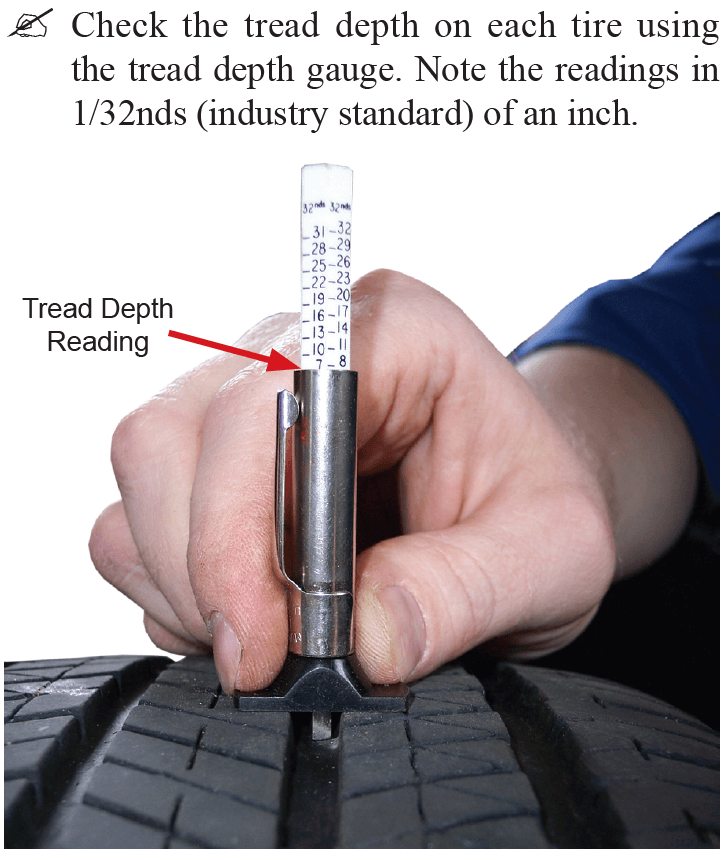How often do you think about your car tires? Weekly? Monthly? Yearly? When you have a blowout? This week, May 29th-June 4th, was designated by the Rubber Manufacturers Association (RMA) as National Tire Safety Week. This is a great time to think about tires since Memorial Day marks the beginning of the summer driving season. The group coins the slogan “Be Tire Smart – Play Your PART” to remind you to take 5 minutes during the month to check your tires. The key to remember is that tire maintenance and safety is a something you should think about all year long.
Light vehicles manufactured after September 1st, 2007 were required by the National Highway Traffic Safety Administration (NHTSA) to have Tire Pressure Monitoring System (TPMS). As a result, vehicles equipped with TPMS have a significant reduction in underinflated tires (See the NHTSA study). But having a vehicle equipped with a TPMS does not replace manually inspecting and checking your tires. According to the RMA “only 17% of drivers are ‘tire smart’ or know how to properly check tire pressure.” Check out their Tire Safety Fact Sheet.

Pressure
So let’s look at the RMA acronym PART – Pressure, Alignment, Rotation, Tread. Correct tire pressure is critical to tire wear and vehicle handling. Tire pressure is measured in pounds per square inch (PSI) or kilopascals (kPa). Improperly inflated tires can lead to tire failure. Look in your vehicle for the tire placard (usually on the driver’s side door or door post). Use a quality air gauge to check tire pressure at least once a month – and don’t forget about your spare. Note: Some cars no longer come equipped with a spare tire to save weight, manufacturer cost, and cargo space.


Alignment
Proper wheel alignment optimizes vehicle handling, maximizes fuel economy, and minimizes tire wear. Have your vehicle’s alignment checked if you have any indication of the vehicle “pulling” in one direction, when specified in your owner’s manual, and when you purchase new tires.

Terms used to describe how a tire aligns with the road are caster, camber, and toe.



Rotation
Moving tires from one location to another is called tire rotation. The front tires tend to wear faster than the back since they absorb turning forces, carry the engine weight, and support the added weight that shifts forward when braking. Rotating tires improves tire life by evening out tire wear. After rotating tires, check tire pressure according to the tire placard on the vehicle. Follow your owner’s manual for tire rotation intervals (usually 5,000 to 8,000 miles) and recommended rotation patterns. Note: Some tires are directional, designed to roll in only one direction and should not be moved to the other side of the vehicle unless they are dismounted from the wheel, flipped, and remounted.

It is important to torque lug nuts in a star pattern with a torque wrench. Torque refers to getting all of the lug nuts to the same tightness. Check your owner’s manual for proper torque specifications.

Tread
A tire with very little tread is more likely to lose traction or hydroplane on wet roads. Tire wear indicator bars run perpendicular to the tread providing a visual, tool free inspection of tread depth. Tread depth is measured in 32nds of an inch. A tire is legally worn out when tread reaches 2/32nds of an inch, the same level as the indicator bars. Using the penny test, place the penny upside down into the tread. Lincoln’s head is approximately at 2/32nds of an inch. (See Measuring Tire Tread Depth with a Coin by TireRack.com)

Ideally, you should consider replacing your tires at 4/32nds of an inch – by using a quarter to measure tread depth vs. a penny. A study by Tire Rack showed that stopping distance is significantly reduced when a tire has 4/32nds of inch of tread vs. 2/32nds. (See Car And Driver article New Tire Tests Show the Quarter is the New Penny)
In addition to a quality air gauge (Car Tire Pressure Gauge is less than $10, Truck Tire Pressure Gauge is about $20), consider purchasing a tread depth gauge (buy one for about $5). A tread depth gauge is a simple device to measure the actual amount of tread remaining on your tires.

Summary
To learn more about tires, check out RMAs Tire Care & Safety Guide. Are you a visual learner? Check out Video.AutoUpeep.com to watch videos about tire maintenance and safety.
The ultimate guide to specifics about your vehicle is your owner’s manual. Crack it open and read it. To learn more, check out my book Auto Upkeep. Auto Upkeep helps keep you safe and your vehicle reliable by providing easy-to-follow information with detailed pictures and drawings. Discover how to choose a quality repair facility, buy a car, handle roadside emergencies, diagnose common problems, and communicate effectively with technicians – all while saving money. Over 100,000 copies have been sold!
About the Author
Mike has roots in the automotive service industry. He began diagnosing and fixing cars at a young age in his family’s service station. He has worked in automotive parts supply stores, towing companies, and service facilities.
After graduating from St. Cloud State University (MN) with a Bachelor’s degree, he implemented and taught a basic car care program at the high school level. During work on his Master’s degree at Illinois State University (IL), he was a curriculum specialist on a National Science Foundation project where he co-authored ten integrated mathematics, science, and technology books designed for team teaching. As an Assistant Supervisor of Career and Technology Education, he supervised over 60 teachers in Career and Technology Education. Currently Mike works full time supporting over 500 teachers and thousands of homeschoolers that use Auto Upkeep.




